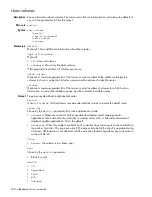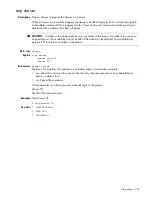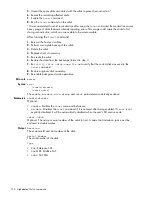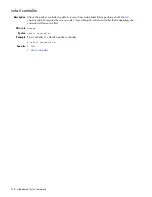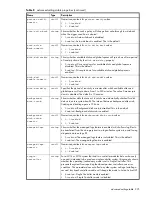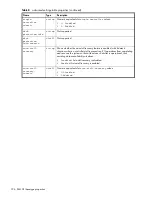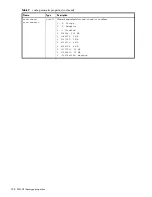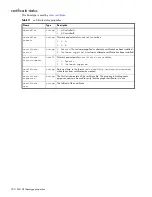
trust 215
trust
Description
Enables an offline or non-fault-tolerant vdisk (or disk group) to be brought online for emergency data
recovery. This command must be enabled before each use. If used improperly this command can
cause unstable operation and data loss. Before use, carefully read the cautions and procedures
below.
The
trust
command provides an opportunity to recover data from a vdisk that has failed due to
disk failure. The command forces a resynchronization of the metadata (as well as time and date
stamps) that unifies members of a vdisk, and essentially puts the vdisk back into an accessible state.
As long as the failed disks are operable, data can be read from the disks and restored to another
location.
Trust should be done only on an offline or non-fault-tolerant vdisk when you have no data backup,
and you want to try to recover the data from the bad vdisk members also. In this case trust may work,
but only as long as the failing disks continue to operate.
When the “trusted” vdisk is back online, back up its data and audit the data to make sure that it is
intact. Then delete that vdisk, create a new vdisk, and restore data from the backup to the new vdisk.
Using a trusted vdisk is only a disaster-recovery measure. The vdisk has no tolerance for any
additional failures.
The following procedure outlines the general steps for performing a trust operation, but the best
procedure to follow for your situation may vary from this procedure. Before starting this procedure, it
is recommended that you contact technical support for assistance in determining if the trust operation
is applicable to your situation, and for assistance in performing it.
CAUTION:
1.
Do not use the
trust
command when the storage system is unstable. For example, if there are
many power or topology-change events.
2.
The
trust
command cannot be run on a quarantined vdisk. In many cases the vdisk will be
automatically dequarantined. If you cannot resolve the issue that caused the disk to become
quarantined such that it is automatically dequarantined, and if the trust operation is applicable to
your situation, dequarantine the vdisk, confirm it is in offline state by using the
command, and then proceed to
trust
.
3.
Never update controller-module, expansion-module, or disk firmware when the vdisk is offline or
non-fault-tolerant.
4.
Never clear unwritten data cache when a vdisk is offline or non-fault-tolerant.
5.
Do not use the
trust
command on a vdisk that failed during vdisk expansion.
6.
Do not use the
trust
command on a vdisk with status
CRIT
. Instead, add spares and let the
system reconstruct the vdisk.
The
trust
command must be used in CLI console mode.
Steps for running the
trust
command
1.
Disable background scrub of disks and vdisks to avoid running scrubs automatically.
2.
Identify the cause for the vdisk becoming offline or non-fault-tolerant.
3.
If an external issue (power, cabling, and so forth) caused the vdisk to fail, fix the external issue
before continuing to the next step.
4.
Disable host access to the failed vdisk. In a single-controller configuration, disconnect the
host-port cables. In a dual-controller configuration:
a.
Determine the owning controller of the failed vdisk.
b.
As a precautionary measure, remove the host-port cables of the owning controller of the
offline vdisk.
Summary of Contents for AssuredSAN 6004
Page 11: ...Document conventions and symbols 11 TIP Provides helpful hints and shortcuts...
Page 114: ...114 Alphabetical list of commands See also set cli parameters show protocols...
Page 139: ...show controller statistics 139 See also reset all statistics reset controller statistics...
Page 162: ...162 Alphabetical list of commands See also show power supplies...








